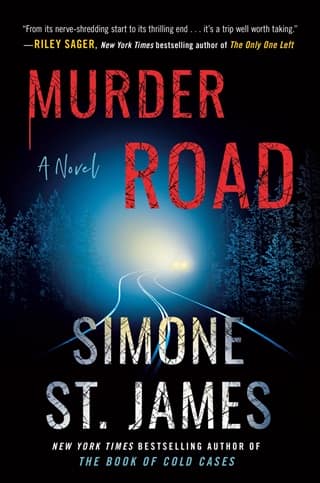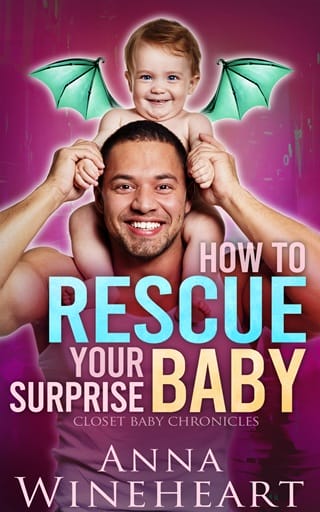Chapter Thirty-Six
CHAPTER THIRTY-SIX
Kal was as good as his word. As Eddie and I drove through Midland, looking for the address Beatrice Snell had left us, he followed politely in his cruiser. Eddie shook his head as I studied the map in my lap.
“Turn left up here,” I said.
“What should we do with him?” Eddie asked.
“I don’t know,” I admitted. “Maybe it isn’t the worst thing in the world to have a little help.”
“He’ll never believe us.”
“Then we don’t tell him everything.” I followed our progress on the map. “We tell him the less crazy parts.”
“Which parts are those?” Eddie’s tone was dry. “I can’t decide.”
“The house is on this street. Number forty-seven. Just up there.”
We were pulling up to a town house complex, a string of small homes attached by the garages. The complex wasn’t new, and the small yards were weedy, with bikes and kids’ toys abandoned next to the porches. An old man smoking a cigarette on his porch watched us as we drove by.
Eddie drove past John Haller’s house and parked farther down the street, next to the curb. Kal Syed’s cruiser parked behind us. I glanced in the rearview mirror and saw the old man promptly stub out his half-smoked cigarette and disappear into his house.
“Haller isn’t going to talk to us,” I said. “Not with a cruiser here. He probably won’t even answer the door.”
Eddie sighed.
Kal got out of his car and walked up to my window, which I rolled down. “Hello, Officer,” I said with one of my fake smiles. “Fancy meeting you here.”
“I’m not leaving,” Kal said. “Are you going to tell me what you’re up to? I can sit here all day.”
I pushed my sunglasses up on my head and took the folded photocopy of the missing person’s report from my purse. I handed it through the window to Kal.
He unfolded it, reading in silence for a minute. “Goddamn it. How the hell did you get this?”
“Check the date,” Eddie said.
“I know, Mr. Carter. I know. A year and a half after we found the body in Coldlake Falls. So there wasn’t a missing person’s report at the time.”
“There’s more,” Eddie said. He took a folded paper from his pocket and handed it over. It was the copy of the classified ad Carla Moyer had placed in 1977.
Kal read that, too. “Do you have any leads on this Carla Moyer?”
“Already talked to her,” Eddie said. “She’s in the phone book.”
“I hate you both.” Kal sighed. “You make me look bad. Were you planning on knocking on John Haller’s door and asking questions? Because I assure you, I’m not going to let you do it. From this point on, I’ll ask the questions.”
“Be our guest,” I said. “We’ll wait right here.”
Kal ducked and looked in my window at us. “You think this is going to get me closer to finding a serial killer? Or do we even have a serial killer? Do you want to give me a clue?”
“From this point on, the clues are your problem,” Eddie said.
“I hate you both. Please turn around and go back to Coldlake Falls now. Or better yet, go home to Ann Arbor.”
“No,” I said.
Without another word, Kal stood and crossed the street to John Haller’s door. We watched him knock, then knock again. The door opened and a man with gray hair in a ponytail opened it. He wore old sweatpants and a T-shirt, flip-flops on his feet. He gave Kal a hostile stare as the policeman spoke, and then his expression changed. He said something back to Kal, an argument of some kind, and when Kal persisted, he stood back and let Kal in.
—Twenty minutes later, Kal emerged from the house, putting his hat back on his head. He strode across the street to our car. “John Haller answered all of my questions,” he said. “His daughter, Shannon, left home in 1976, wanting to travel and find herself. She was an addict and an alcoholic with mental problems. He never saw her again. He waited over a year for her to come home, and then he filed a missing person’s report. Nothing ever came of it.”
“Can Shannon be connected to the unidentified body you found?” Eddie asked.
Kal sighed. “The dental records would do it, if we still have them. We’d have to track down Shannon Haller’s dentist and find out if he still has nineteen-year-old records. If that’s a dead end, I’ll check if any blood or tissue samples were taken from the body and kept all this time. If not, the unidentified girl was buried in one of the graveyards in Coldlake Falls. We’d have to exhume her, which takes a ruling by a judge and a lot of money. And even if we do have samples saved from the postmortem, we’d have to run DNA tests, which take a lot of time and cost a lot of money. We’d also have to run DNA from John Haller to match the results, if he even agrees to give a sample. All of this is above my pay grade. But I’ll try.” He looked at us. “This is in the right hands now, and there’s nothing else the two of you can do. You can turn around and go back to Coldlake Falls now.”
I glanced at Eddie. He had turned to look at John Haller’s house, which was quiet. He seemed to be deep in thought, so I turned back to Kal.
Our eyes met. We were thinking the same thing: Even if the body could be proven to be Shannon’s, her murder still wasn’t solved. Max Shandler was a child when Shannon was killed. I knew now—or had an idea—how the others had been murdered, if not who the killers were. But who killed Shannon?
“You could help, you know.” Kal’s voice was low. “If you tell me what you know, or what you think you know. We’re no further ahead than we were before—you know that. You could change that situation.”
Right. Go into the Coldlake Falls police station again? Sit in that little room with Quentin and Beam and tell them what happened to me last night? Tell them that their serial killer was a literal ghost? That wouldn’t help anyone, least of all me.
“I can’t help you,” I told Kal, because I owed him something that wasn’t a lie.
His brows drew down in concern. “Is someone threatening you?”
What a loaded question that was. “In a way,” I said. Shannon’s ghost was definitely threatening me.
He tried not to look defeated. “I have to go back,” he said. “I’ll write a report and start the process of identifying her the best I can. That poor man lost his daughter. I ask that you please don’t bother him.”
“Of course we won’t,” I said.
Kal gave a reluctant nod, and then he got back into his cruiser, started it, and drove away.
Eddie was still staring at the house, unmoving.
“Eddie?” I asked. We’d been sitting in this hot, still car for too long. Sweat was soaking my back.
“Just wait.” Eddie’s voice was calm, detached. He didn’t move.
I opened my mouth to say something else but stopped. For once, I agreed with Kal—we should go back to Coldlake Falls. I wanted to see if the Snell girls had found Trish. I wanted to know if she was okay, if she remembered last night. I wanted to know if there was a way to find out how the case against Max Shandler was progressing.
But Eddie was so still, it was scaring me. He was watching for something, for someone. For a second I pictured him just like this in the desert somewhere, waiting for the enemy, and despite the heat in the car, I shivered.
A minute ticked by, then another. The front door of John Haller’s house opened and he came out. Without looking left or right, he got in his car and pulled out of the driveway, heading in the opposite direction from Kal.
“Perfect,” Eddie said, his voice still as detached as a robot’s. “Now.”
“Now what?” I asked.
“Now we go in.”
He couldn’t be serious. “To the house? What are you talking about?”
Eddie turned and looked at me. “She lived in that house, April. Grew up there, maybe. Had a bedroom there. He probably still has her belongings, old photos. There’s still a lot more to find.”
“That’s breaking and entering!” I hissed. “Eddie, we’re done here. We need to leave.”
But he didn’t hear the end of my sentence. He was already out of the car, moving swiftly across the street toward the house. I had no choice but to get out and run after him.
He was fast—army fast. He moved down the attached row of houses with silent speed, his feet making barely a sound on the pavement. Around the corner was a gate opening to the narrow lane behind the houses’ backyards. As if he’d been here a dozen times, Eddie unlatched the gate and slipped through.
I followed, trying to keep pace. I had never seen Eddie move like this, as if he was on a mission. He knew exactly what he was doing.
We passed the back gates of several houses, and Eddie stopped at one, pressing his hand to it. It was locked from the inside. He gripped the top of the wooden fence, hoisted himself over, and dropped down. A second later, the gate opened for me as he unlocked it.
“Eddie, stop,” I tried to whisper, but he was already gone.
The screen door creaked as Eddie opened it, trying the handle of the back door. Locked. He moved to the nearest window, which looked into the kitchen. He ran his hands over the edges of the screen, feeling with his fingertips. He popped the screen off and dropped it to the ground, leaning it against the house. He fiddled with a latch in a way I couldn’t see, lifted the window, and disappeared inside.
The whole operation had taken seconds.
My heart was pounding, and cold sweat had replaced the heat from the car. This was wrong, all wrong. We weren’t supposed to be here. Eddie wasn’t a thief; I had never seen him act like this. I hadn’t thought he knew how to break into houses. Why was he so determined to break into this one? What did he think he was going to find?
I hesitated, glancing around. What if a neighbor saw us from a window? The police could be here in minutes. I walked to the window and pulled myself over the sill, swinging my feet down to the kitchen floor inside.
The house was dim and quiet. It was small, untidy, run-down—the house of a man who lives alone as he grows older, year after year. Empty beer bottles lined the kitchen counter, and my sneakers touched something sticky on the yellowed linoleum floor.
I couldn’t see anything unusual. There were auto magazines on the kitchen table, an ashtray with cigarettes stubbed out. An empty can of baked beans in the sink. John Haller had no wife, no photos on the fridge. His daughter had left long ago, and Carla had said that Shannon’s mother was dead.
Eddie had moved to the front room, where he was looking at a shelf of dusty old books. He bypassed the sparsely filled liquor cabinet and opened a cabinet door, peering in.
“Eddie, we need to leave,” I said.
“This will be fast.” He was still peering into the darkness of the cabinet. “We’ll just find Shannon’s things and go.”
“She left years ago. How do you know he still has her things?”
“Where else would they be?” He closed the cupboard and looked around the living room. “Nothing here, I think. Probably upstairs.”
“Eddie!” I tried to keep my voice low in case the neighbors could hear through the walls. But what could I do? He was already moving up the narrow stairs, taking them two at a time.
I looked around the living room, debating whether to follow him. There were no photos in here, either, no framed family pictures on the end tables or above the TV.
My eye caught on something—a cabinet below the TV, the door partly open. Inside I could see the thick pages of a photo album.
I crouched down, sliding the door open. The album had been pulled to the front of the cabinet, as if it had been taken out and carelessly put away. Despite the urge to run, I opened it.
There were loose photos inside the album, along with some stuck to the pages and covered with cling film. I picked up the top loose photo and looked at it.
The photo was of two young women of maybe twenty, their arms around each other’s shoulders. I immediately recognized Carla Moyer, though her hair was cropped just below her ears in the photo and her face was round, babyish, carefree.
The other girl had brown hair, worn past her shoulders. She was smiling widely at the camera, grinning in the sunshine, but I immediately went cold.
It was the Lost Girl. It was Shannon Haller.
I didn’t need Kal Syed’s evidence—dental records, DNA, blood tests. I already knew that the body on Atticus Line was Shannon’s because I’d seen her last night in Trish’s rearview mirror.
The album had been moved recently because Kal had just been here, talking to John Haller. He had probably asked him for a photo of Shannon, and John had picked one from this pile. Then he’d hastily put the album back.
I picked up the second photo. Shannon carried a small boy on her hip. She was pointing to the camera, trying to get him to smile at the lens. She wore a ringer tee, and she was too thin, her cheekbones sharper than in the other picture, faint shadows under her eyes. The boy had been caught as he turned his face away from the camera, and his features were blurred. He looked about four or five years old.
I stared at the picture for too long. I’d thought Shannon had a baby when she disappeared, not a little boy. Shannon had a baby she wanted to dry out for, Carla had said. But she hadn’t specified when that was, what year. I’d just assumed she was talking about the year Shannon had disappeared, and so had Eddie. The math doesn’t add up, Eddie had said. Shannon had a baby, not an eight-year-old in 1976. That was some other kid. Not me.
He was wrong. Shannon hadn’t just given birth when she disappeared. She had a little boy, who had been taken away from her and put in foster care. I squinted at the photo, but it was too blurry, and the little boy was turning away. I couldn’t see his face.
A muffled thump came from upstairs. I shoved the photo in my back pocket, pushed the album back, and closed the door. We’d been here too long. We had to get out of this house.
 Fullepub
Fullepub 



